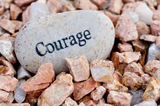Think it over
In defence of pain
Abstract
For most of us, the idea of willingly submitting to discomfort and pain is absurd. Why would we be so foolish to subject ourselves to such a thing? But when pursued wholly — in body, mind and spirit — and with deep self-compassion and love, the results can be life-changing. By working with and through pain, we can not only make the past and present more malleable, but we can also forge a kinder, less painful future. Nor are the efforts and rewards singular. This self-evolutionary process is one that has the potential to radiate out to those around us, both as an influence and an offering for a happier, more contented and transcendent life.
Corporeal punishment
Somewhere, after around hour three of overnight meditation at the zendo where my Buddhist group meets, I start to imagine myself doing that breathing that women in labour do while their partners rub their shoulders, whisper soothing words and cheer lead them through the stabbing contractions. I have no partner or cheerleading team here in the pitch-black and somewhat stinky dojo, nor does a mellow massage await. I’d say the pain level is getting close to bone-snapping and the night ahead is still long. Yet I don’t move. I don’t even twitch. My face remains slack as my knee, shin and ankle silently scream, seize, and then settle into a searing throb, but I just focus on the rhythm of my breath and stay put.
Am I mad? Perhaps. I admit it’s a question that ricochets through my head during those monotonous hours, and yet I continue my practice day after day, week after week, monthly sesshin after long-haul sesshin. Rest assured, I get no masochistic zing from physical pain; I think I have a pretty low tolerance, in fact, and like most others, rather actively avoid it and its milder counterpart, discomfort. The reasons are varied, and perhaps some even unconscious, but the simple fact is that I keep it all up because of the benefits. “Benefits?” Yes. The benefits of the pain and discomfort are surprisingly and satisfyingly compelling and over time I’ve come to consider both of these states as tools, teachers, and, I daresay, even friends.
When the body speaks, how well do we listen?
Let’s start with the most tangible — the physical. Physical pain is straightforward: “Ouch!” “Ow, ow, ow, ow, ow!” “Aaaahhhhhhhhhck!!!”No misinterpretation there. The physical is clear-cut and measurable, so any changes in quality — for better or worse — are fairly easy to perceive. My meditation teacher, who trained for the Olympics and had his aspirations dashed by a broken leg, tells of his long recovery and first agonising attempts at the lotus position when he started sitting in zazen. The story is painful just to hear. But to see him now whip his leg Gumby-like onto his opposite thigh and not bat an eye is a testament to what can be achieved.
Well, who cares if he can now twist himself into this circus-like posture and remain (at least externally) serene for hours? Seriously, what’s the ROI? Because that’s what most of us humans are all about. What sort of tangible rewards will he gain through his relentless work and dedication? Fame? Fortune? Twitter followers and Facebook Friends? I’m fairly certain not. In fact, I suspect my teacher has only the vaguest notion of what a tweet or a poke might be in the modern sense, but I also imagine that this has helped him quite a bit in cultivating his achievements.
I haven’t quizzed him deeply on the topic, but I think I can relate somewhat. The physical challenges I’ve experienced in my own yoga and meditation practices have shown me that while the process of corporeal evolution can feel tortuous at times, it can also be quite exhilarating. When we increase our capacity for physical discomfort, we increase physical capacity itself, usually resulting in an improved state of health — increased flexibility, strength, endurance, blood and oxygen flow, cardiovascular efficiency, nervous system response, etc. A physical sense of well-being almost invariably leads then to an even broader sense of ease and flow — comfort in one’s own body, a calmer spirit, a brighter outlook on life.
The big leagues of pain
Taking on emotional or psychological pain in this process, however, is the big leagues — an uncharted trail that requires some serious courage. Most of us have been ill-educated in navigating this terrain; for the most part, Western culture starts whistling loudly and checking its text messages when these issues show up. But by first facing and overcoming the physical, we’re often surprised and rather pleased with our fortitude, and from it we gain momentum. What had been the intimidating unknown now morphs into the surmountable known and we then find mental, emotional, or even spiritual distress less daunting. At times we’re even drawn to the challenge of exploring it.
This process of facing, engaging with and ultimately embracing non-physical discomfort and pain has the potential to generate life-changing benefits. Yet the road can be rocky. The very rewards that we may have yearned for throughout a lifetime can suddenly loom terrifying and intimidating before us in the moment of becoming real. “Be careful what you wish for,” we’re reminded by well-meaning others. But that’s precisely when the cumulative practice we’ve worked so hard at comes into play. From our past experience we now possess the conscience and ability to take a deep breath, focus, and dive into the abyss.
Peeling back the layers
Meditation is just one of the myriad approaches to this type of undertaking. When we consent to deliberate inactivity and quiet, all the wily ways that we usually use to distract ourselves from a deeper, unadorned examination of our inner selves begin to dissolve. Little by little, we become like the Wizard of Oz when Dorothy pulls back the curtain — exposed, frightened, naked in all of our damaged, sweet, vulnerable and beautiful humanity. We’re given the opportunity to return to the past and view it differently or make peace; we can accept the present and perhaps get a better understanding of just how acutely fleeting it is; and we can let go of the elusive and myopic future of our imagination.
The many blows and injustices visited upon us throughout our lives will never be erased, but sitting in meditation, captive to nothing but our own memory and thought process, we have an unfettered choice as to how we will move forward. The pain and discomfort become a bridge to courage. If we are bold enough to open humbly to this mysterious unknown time and time again, we gradually find our whole being begin to ripen. Our efforts lead to tolerance, tolerance to acceptance, acceptance to compassion, and compassion to love. When we’re able to connect consistently and unflinchingly to self-love, the painstakingly cultivated walls begin to crumble and we’re able to perceive an almost euphoric sense of freedom within. From the contented self comes the desire to share; a centrifugal expansion begins to occur from ourselves to others. Everyone’s suffered. Everyone fears. Everyone aches for love. We are all connected and at our core longing to live in internal and external harmony. Imagine the possibilities.
Kelly Johnston is an integrative health coach and consultant based in Mexico City. She hosts a website and blog at http://www.life-equilibrium.com.
Share with us (Comments,contributions,opinions)
When reproducing this feature, please credit NAMAH,and give the byline. Please send us cuttings.




